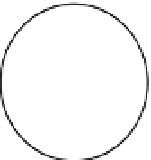Java Reference
In-Depth Information
original location is somewhere below the bottom of the screen. Since we will be moving
bonusBalloon
around the screen and we want to know if the
Node
flyingNode
intercepts it, it makes sense to normalize
both the coordinates of the
bonusBalloon
and the
flyingClown
Nodes
.
Main.offsetFromZero
from Listing 11-1 performs this function by wrapping each
Node
in a new
Group
and adjusting the
translateX
and
translateY
values of the
Group
and the
Node
so that the
Node
stays in
the same visual location on the screen. But the returned
Group's
translateX
and
translateY
values
reflect its position relative to the upper left of the screen.
The function
initScreen
is called by the
init
function of the class
GameModel
. If we look at the
function
startGame
from Listing 11-1, we see that the
GameModel
is constructed before the transition
FlipReplace
is called. Recall from Chapter 3 that each transition allows the caller to specify a function
that should be called when the transition is complete. When the
FlipReplace
is done it calls the function
GameModel.startingAnimationOver
, which actually gets the
GameModel
ready to start playing the game.
Figure 11-8 shows how the game state is managed by the class
GameModel
.
In Figure 11-9 we see that the function
startingAnimationOver
gets the ball rolling by calling
startRound
after the instructions fade out. The function
startRound
readies the game by resetting the
angle of the cannon, setting the number of clowns to five, and randomly distributing the pegs.
Figure 11-9.
Game state
In Listing 11-3 we can see that the function
startRound
adds a
Body
to a
World
object. Both
Body
and
World
are classes from Phys2d and are used to do our physics simulation. Chapter 6 describes how this
works. But be reminded that by adding
Bodies
to a
World
you can then use the
World
object to calculate
the location of the clown and the pegs as the game plays out. We can see that the function
startRound
calls
readyLaunch
, which resets the location of the
Node
balloonNode
, resets the location of the
Node

























































